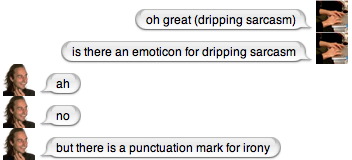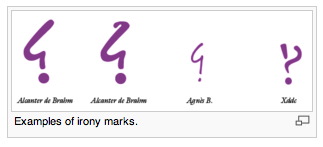The following exchange occurred this morning during a long IM session with a close friend and colleague:

Turns out there is an actual punctuation mark in French to indicate irony which you can read about in this wikipedia article.

I don’t actually use emoticons because i find them so aesthetically uninteresting, so i love the idea of a new class of punctuation marks evolving to take the place of the smiley face in all its saccharine implementations.
if:book
A Project of the Institute for the Future of the Book

It’s true that Alcanter de Brahm *proposed* an irony mark. But it was ridiculed and never widely adopted. Good writers don’t need a mark to tell good readers when they are being ironic. If the mark ever caught on, then some good writers would use it ironically, forcing us back to where we began, detecting irony solely from contexual clues.
A nice twist on the old saw, ‘The French have a word for it.’ The same character has also been suggested for a combination of query and exclamation, the ‘interabang’. Unfortunately the ‘interabang’ still hasn’t made it to the mainstream.
A Slate piece in 2004 suggests retro-signfying the Spanish-language inverted exclamation mark for irony. At least it’s adaptive, if perhaps in the end confusing. The inverted question mark might prove a valuable addition too.
Just when will The New Punctuation Movement (my coinage) move from the humor columns to the keyboard!? It’s time to cull the most useful of the emoticons and adapt them to the type case. And retire the smiley-face … maybe.
“I don’t actually use emoticons because i find them so aesthetically uninteresting, so i love the idea of a new class of punctuation marks evolving to take the place of the smiley face in all its saccharine implementations.”
To you, emoticons might seem like “saccharine” punctuation, but for today’s youth, it is an accepted form. It’s really just a matter of time before emoticons become the norm, and maybe even become much more formalized. I doubt a top-down approach to “proper” punctuation would ever get much hold. It’s the youth that change language, and it’s them whom you’ll have to convince to change the way they communicate.
I was skeptical of emoticons at first, but I now find them much more interesting than any explicit form of punctuation. For some time I saw people try a HTML-like form of punctuation: <sarcastic>yeah right!</sarcastic>, but I always found that too sterile.
I think an “irony mark” leaves almost no room for ambiguity. Similar to the way you probably wouldn’t want to have a “joke mark”, I think suggestive punctuation marks, like emoticons, are both clear an ambiguous enough, depending on context, that they allow to communicate very complex and creative ideas (like humor!).
What I find interesting is the written language has, throughout history, been reserved for the most educated… so formalization has been relatively easy to maintain, while spoken language has been much harder to control. But now, with many more literate youth living than in anytime in our history communicating with text, I expect changes in the written language to happen at a much more rapid pace.
Actually, you can see it already: Online, hyperlinking has changed the way people lead to and suggest external ideas. 🙂
Yes. Rather than going to the (type) case for punctuations of the page there should be some attentive regard for the punctuations of the screen. Just as the pop-up hand confirms an underlying linkage, screen punctuation should jump into view underlying the period. (or two)
There should also be some attentive regard for the malapropt subject line in ongoing threads.
The true trouble with an irony punctuation mark is that there is no telling when it has been deployed ironically: punkt, snark, zing.
cf. Benjamin Franklin, printer and early American ironist.
Eddie says:
“What I find interesting is the written language has, throughout history, been reserved for the most educated… so formalization has been relatively easy to maintain, while spoken language has been much harder to control. But now, with “many more literate youth living than in anytime in our history communicating with text, I expect changes in the written language to happen at a much more rapid pace.”
An editorial on today’s Times talks about the new “national report card.” The National Assessment of Educational Progress finds that American 12th graders are performing worse in reading than 12th graders did in 1992. Today, only about 35 percent of 12th graders are proficient in reading. The editorial stresses that marginal literacy and minimal math skills might have been adequate for the industrial age, but that they are not enough for today. If there are “many more literate youth living than in anytime in our history communicating with text, ” then something is missing somewhere. The national panic about the illiteracy of American youth doesn’t seem to consider that the way schools function (regimented chunks of time, bells, timed testing) is a product of the industrial age. Youth today live in the technological era but are educated, and tested, for the industrial age. Their language does not conform solely to the written text anymore; they respond to many languages, they are multimedia. It is precisely there where emoticons make sense. Youth change language only superficially; neologisms tend to fall out of use while permanent structural changes respond to a long evolution. Many factors influence language, such as changes in society, other languages, scientific and technological advances that require new lexicon, and so forth. Youth are early adaptors and if they are spending the amount of time they are on the Internet we should be teaching them for the era they belong to. And that includes not only new lexicon, but perhaps punctuation marks that go along with a world where text has become more relevant than ever in daily communication.
I just pray we don’t see the day when the young IM community starts to define written language. Right after we have a punctuation mark for the sad and happy emoticon we’ll get letters and numbers together to emphasize style.
While youth these days interact with text a lot more than previous generations, they do it focusing on being efficient: they have six different messanger windows open at the same time, they SMS with the numeric keypads of their cellphones, they know if you type fast enough on IM you can overcome most arguments. So we get ‘lol’, ‘grl’, :-P, and the dreaded L337.
But I agree with Eddie, what we should do is to adapt the way we teach them, so we can lead them to use the new media to create significative changes to the written languages. Ignoring the possibilitites is just as bad as having “efficient” literature.
A great, or even competent writer, can take a reader on a linear narrative, and say a great deal more than the sum of the words. Using context, timing and other techniques to bring forward ironic meanings in the material is relatively easy.
However, the irony mark is a very valid tool. In newer media, things are not so controlled as a book. Just because a good novel-writer can get by without it, should the IM example above be deprived? Those five lines are not the most epic words, but they are communication, and really should have been serviced by our punctuation.
I am the self-proclaimed number one supporter of the snark. It is an updated irony mark that requires no new metal type, and is simple to add to our punctuation vocabulary. The snark is not a tag for any and all irony. It is a mark to show whenever irony would be intoned, if the text were to be read.
I showcase the usage, design and history at:
http://thesnark.org
At the site, we have decided on a top-down and bottom-up approach. Please come by, and if you like it, comment or drop me a line! I seek to hear from anyone interested, from readers to authors to designers, and invite you to join in the campaign.